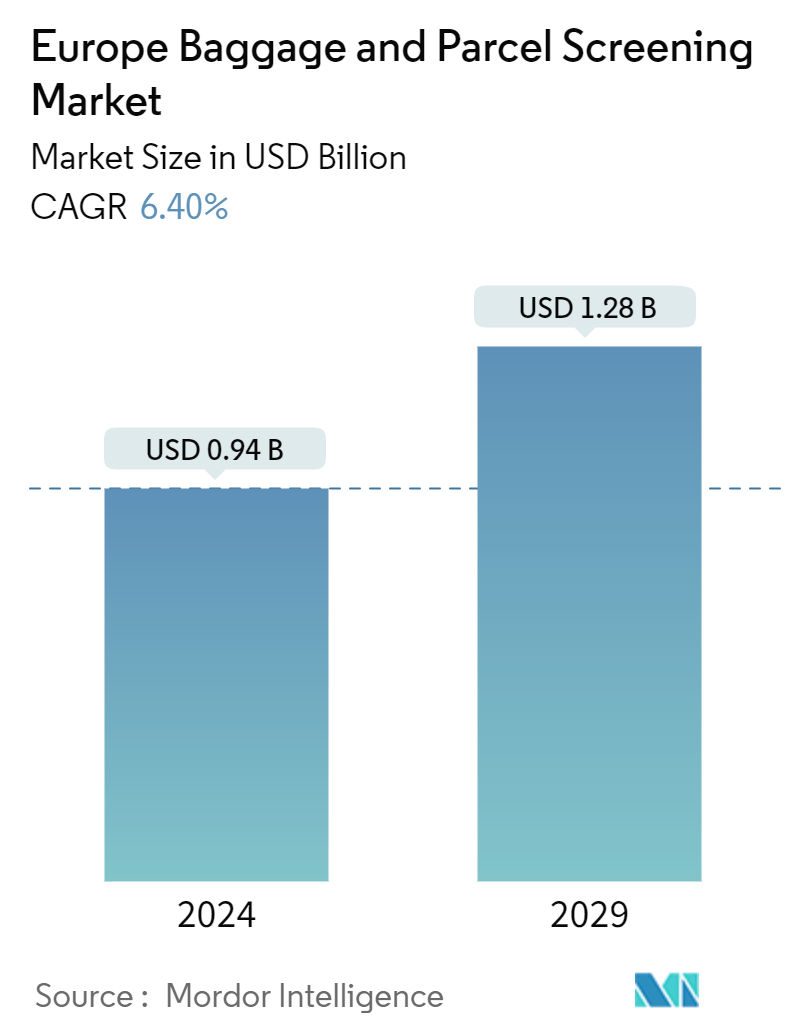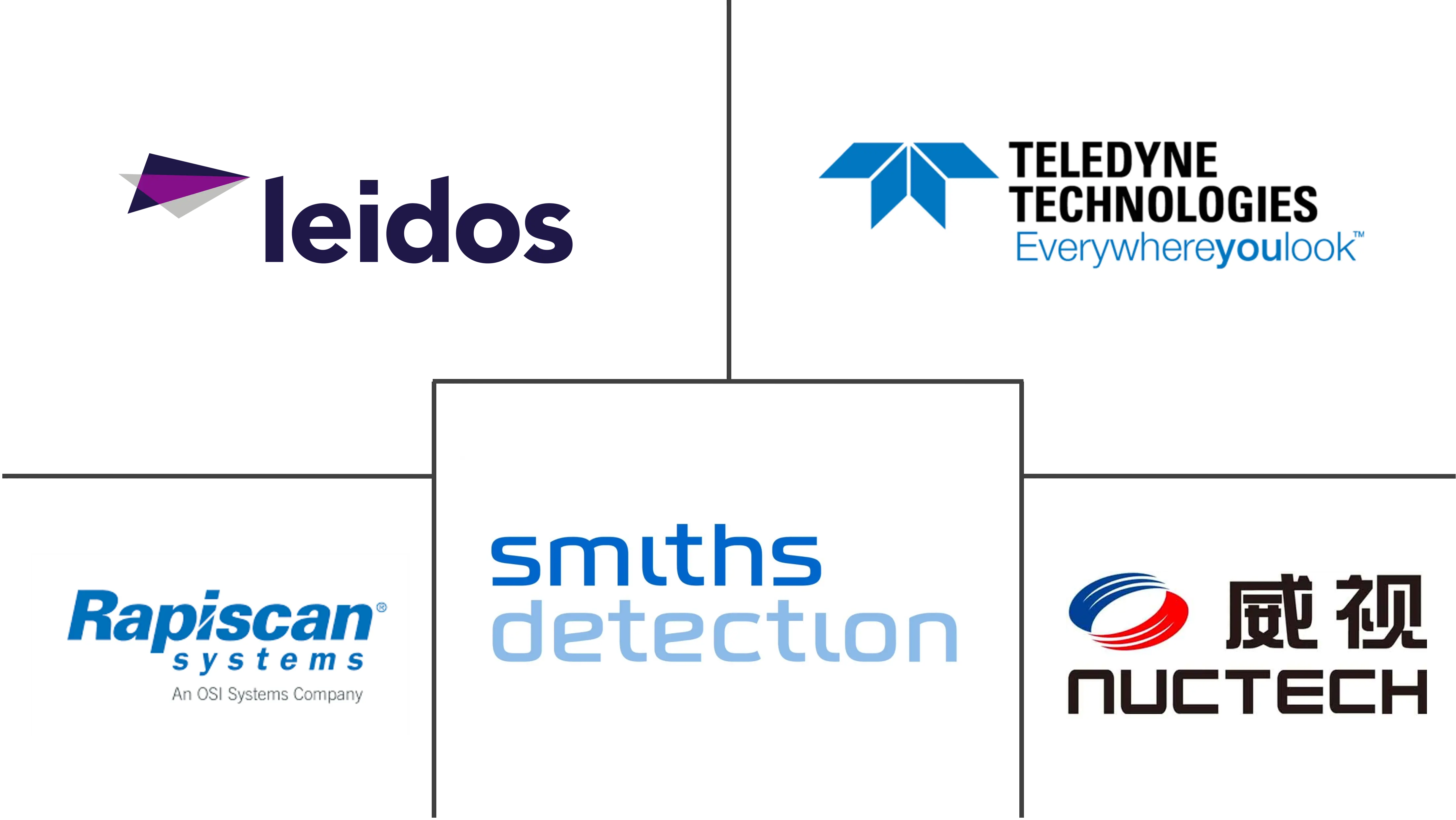Market Size of Europe Baggage And Parcel Screening Industry

| Study Period | 2019 - 2029 |
| Base Year For Estimation | 2023 |
| Market Size (2024) | USD 0.94 Billion |
| Market Size (2029) | USD 1.28 Billion |
| CAGR (2024 - 2029) | 6.40 % |
| Market Concentration | Low |
Major Players
*Disclaimer: Major Players sorted in no particular order |
Europe Baggage And Parcel Screening Market Analysis
The Europe Baggage And Parcel Screening Market size is estimated at USD 0.94 billion in 2024, and is expected to reach USD 1.28 billion by 2029, growing at a CAGR of 6.40% during the forecast period (2024-2029).
The market is expanding primarily due to the surge in criminal activities, the growing need for enhanced public surveillance, and an increasing demand for security screening in the private sector.
Baggage and parcel screening plays a pivotal role in security measures across European airports and transit hubs. Similarly, cargo screening is paramount in curbing illicit activities at seaports. Many European nations are ramping up security not just at airports but also at bus depots and train stations, responding to a surge in terrorist threats and crimes.
The uptick in air cargo utilization for swift goods transport is driving a parallel surge in the tech adoption of cargo screening at airports. Consequently, Europe has witnessed a notable uptick in deploying bomb-detecting tech and screening devices. European legislators have mandated 100% cargo screening for all outbound passenger flights.
While the European shipping industry expands, driven by containerization and globalization, it has inadvertently heightened security concerns for ports worldwide. This, in turn, is fueling the demand for security screening solutions in the transportation sector.
Integrating information technology into logistics and baggage management has significantly boosted service quality and operational efficiency at airports. Leveraging technologies like artificial intelligence and RFID further minimizes baggage mishandling.
In March 2023, the Royal Schiphol Group, managing Amsterdam’s Schiphol Airport, announced a collaboration with Pangiam, a security tech firm. Its goal is to pioneer a more efficient and secure hand baggage screening method powered by artificial intelligence. This innovation not only promises faster security checks for travelers but also ensures heightened safety. If successful, this technology could revolutionize hand baggage screening not just at Schiphol but across various airports.
Yet, certain screening technologies, like those involving X-rays or radiation, raise environmental and health concerns. This could lead to heightened scrutiny and potential restrictions, making screening systems more complex and costly, potentially impacting market growth.
Lastly, several EU countries and airport authorities are teaming up to establish dedicated air cargo terminals with advanced security protocols. This collaborative effort is poised to offer lucrative prospects for businesses in the baggage and parcel screening market. Furthermore, forging strategic alliances in the supply chain and partnering with the International Air Transport Association (IATA) could pave the way for sustainable growth for organizations.
Europe Baggage And Parcel Screening Industry Segmentation
Baggage and parcel screening is a necessary process in which baggage and parcels undergo electronic screening at airports, ports, borders, and other locations before being permitted on the aircraft. This crucial security process involves the utilization of metal detectors and identity controls. The study tracks the key market parameters, underlying growth influencers, and major vendors operating in the industry, which supports the market estimations and growth rates over the forecast period. The scope of the report encompasses market sizing and forecast for segmentation by detection technologies, end-user industries, and geography.
The European baggage and parcel screening market is segmented by detection technology (X-ray, CT-based, neutron sensing and detection, explosive trace detection (ETD), and other detection technologies), end user (airports, ports and borders, defense, critical infrastructure, commercial, and law enforcement and transportation), and country (United Kingdom, Germany, France, and Rest of Europe [Nordics and Other European Countries]). The market sizes and forecasts are provided in terms of value (USD) for all the above segments.
| By Detection Technology | |
| X-ray | |
| CT-based | |
| Neutron Sensing and Detection | |
| Explosive Trace Detection (ETD) | |
| Other Detection Technologies |
| By End User | |
| Airports | |
| Ports and Borders | |
| Defense | |
| Critical Infrastructure | |
| Commercial | |
| Law Enforcement and Transportation |
| By Country*** | |
| United Kingdom | |
| Germany | |
| France |
Europe Baggage And Parcel Screening Market Size Summary
The European baggage and parcel screening market is experiencing significant growth, driven by the increasing need for enhanced security measures across various transportation hubs, including airports, bus depots, and train stations. This demand is largely fueled by a rise in criminal activities and terrorist threats, prompting European nations to bolster their security protocols. The market is characterized by the adoption of advanced technologies such as artificial intelligence and RFID, which are being integrated into logistics and baggage management systems to improve operational efficiency and minimize baggage mishandling. Collaborations, such as the one between the Royal Schiphol Group and Pangiam, aim to innovate screening methods, potentially revolutionizing security checks at airports. However, concerns regarding the environmental and health impacts of certain screening technologies, like X-rays, could pose challenges to market expansion.
The market's growth is further supported by the expansion of the European shipping industry, driven by containerization and globalization, which has heightened security concerns at ports. This has led to increased demand for security screening solutions in the transportation sector. The implementation of advanced X-ray imaging solutions is becoming crucial for ensuring the safety of passengers and facilities, with companies focusing on innovation and customization to meet evolving market demands. The ongoing developments at airports, such as the upgrades at Prague Airport and the introduction of computed tomography scanners at London City Airport, highlight the industry's commitment to enhancing security measures and adapting to regulatory changes. As international travel continues to rise, the importance of robust and efficient baggage screening systems is underscored, offering lucrative prospects for businesses in the market.
Europe Baggage And Parcel Screening Market Size - Table of Contents
-
1. MARKET INSIGHTS
-
1.1 Market Overview
-
1.2 Industry Attractiveness - Porter's Five Force Analysis
-
1.2.1 Bargaining Power of Suppliers
-
1.2.2 Bargaining Power of Buyers
-
1.2.3 Threat of New Entrants
-
1.2.4 Threat of Substitute Products
-
1.2.5 Intensity of Competitive Rivalry
-
-
1.3 Assessment of the Impact of Macroeconomic Trends on the Market
-
-
2. MARKET SEGMENTATION
-
2.1 By Detection Technology
-
2.1.1 X-ray
-
2.1.2 CT-based
-
2.1.3 Neutron Sensing and Detection
-
2.1.4 Explosive Trace Detection (ETD)
-
2.1.5 Other Detection Technologies
-
-
2.2 By End User
-
2.2.1 Airports
-
2.2.2 Ports and Borders
-
2.2.3 Defense
-
2.2.4 Critical Infrastructure
-
2.2.5 Commercial
-
2.2.6 Law Enforcement and Transportation
-
-
2.3 By Country***
-
2.3.1 United Kingdom
-
2.3.2 Germany
-
2.3.3 France
-
-
Europe Baggage And Parcel Screening Market Size FAQs
How big is the Europe Baggage And Parcel Screening Market?
The Europe Baggage And Parcel Screening Market size is expected to reach USD 0.94 billion in 2024 and grow at a CAGR of 6.40% to reach USD 1.28 billion by 2029.
What is the current Europe Baggage And Parcel Screening Market size?
In 2024, the Europe Baggage And Parcel Screening Market size is expected to reach USD 0.94 billion.

